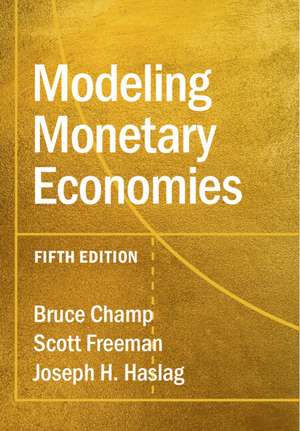Modeling Monetary Economies
Autor Bruce Champ, Scott Freeman, Joseph H. Haslagen Limba Engleză Paperback – iun 2022
| Toate formatele și edițiile | Preț | Express |
|---|---|---|
| Paperback (1) | 351.97 lei 6-8 săpt. | |
| Cambridge University Press – iun 2022 | 351.97 lei 6-8 săpt. | |
| Hardback (1) | 739.98 lei 6-8 săpt. | |
| Cambridge University Press – iun 2022 | 739.98 lei 6-8 săpt. |
Preț: 351.97 lei
Nou
Puncte Express: 528
Preț estimativ în valută:
67.36€ • 69.92$ • 56.16£
67.36€ • 69.92$ • 56.16£
Carte tipărită la comandă
Livrare economică 22 martie-05 aprilie
Preluare comenzi: 021 569.72.76
Specificații
ISBN-13: 9781009096508
ISBN-10: 1009096508
Pagini: 475
Dimensiuni: 176 x 254 x 23 mm
Greutate: 0.73 kg
Ediția:5Revizuită
Editura: Cambridge University Press
Colecția Cambridge University Press
Locul publicării:New York, United States
ISBN-10: 1009096508
Pagini: 475
Dimensiuni: 176 x 254 x 23 mm
Greutate: 0.73 kg
Ediția:5Revizuită
Editura: Cambridge University Press
Colecția Cambridge University Press
Locul publicării:New York, United States
Cuprins
List of figures; List of tables; Preface; Part I. Money; 1. The economy and the planner's solution; 2. Equilibrium trade in the economy without money; 3. A simple model of money; 4. Barter and commodity money; 5. Inflation; 6. International monetary systems; 7. Price surprises; Part II. Capital and Banking; 8. Capital; 9. Liquidity and financial intermediation; 10. Central banking and the money supply; 11. Money stock fluctuations; 12. Fully backed central bank money; 13. Payment systems; 14. Bank risk; 15. Liquidity risk and bank panics; Part III. Government Policy; 16. Deficits and the national debt; 17. Savings and investment; 18. The effect of the national debt on capital and savings; 19. The temptation of inflation; References; Index.
Recenzii
'My students and I have enjoyed using this excellent text because of its clear presentation and use of a simple overlapping generations model to analyze fundamental issues in monetary economics. The new edition retains this approach and expands its coverage of financial stability issues and recent developments in monetary policy. This is clearly the best undergraduate text on monetary economics.' Michael Ellis, Kent State University
'Modeling Monetary Economies is the only textbook that allows undergraduates to learn important results and applications in monetary economics in a rigorous theoretical framework. The fifth edition continues this tradition with the addition of a discussion of blockchains as a monetary record-keeping system, as well as updated applications of the theory to the 2007–8 financial crisis and pandemic-related monetary policy.' Michael Loewy, University of South Florida
'This primer on monetary economics, written by three stalwarts in the field, is already a classic. The material covered is outstanding in its breadth and depth. Unlike other money and banking texts, this one asks more of the reader, but delivers a whole lot more. The writing is fresh and intellectually stimulating, rigorous, and yet approachable. I love this new edition and wish it continued success in its efforts to bring serious monetary economics to the reach of the curious undergraduate.' Joydeep Bhattacharya, Iowa State University
'The textbook Modeling Monetary Economies provides a rigorous treatment of money, banking, and financial intermediation within a unified framework that is accessible to advanced undergraduate students. It addresses the most fundamental questions in monetary theory - e.g., Can fiat money be valued in equilibrium? Can it coexist with interest-bearing assets? Why do banks exist? - without shortcuts. It also covers material that is relevant for today's problems, including cryptocurrencies and blockchain technologies, the design of payment systems, bank regulations, the welfare costs of inflation … It is a must-read for all students interested in monetary issues.' Guillaume Rocheteau, University of California, Irvine
'Modeling Monetary Economies is the only textbook that allows undergraduates to learn important results and applications in monetary economics in a rigorous theoretical framework. The fifth edition continues this tradition with the addition of a discussion of blockchains as a monetary record-keeping system, as well as updated applications of the theory to the 2007–8 financial crisis and pandemic-related monetary policy.' Michael Loewy, University of South Florida
'This primer on monetary economics, written by three stalwarts in the field, is already a classic. The material covered is outstanding in its breadth and depth. Unlike other money and banking texts, this one asks more of the reader, but delivers a whole lot more. The writing is fresh and intellectually stimulating, rigorous, and yet approachable. I love this new edition and wish it continued success in its efforts to bring serious monetary economics to the reach of the curious undergraduate.' Joydeep Bhattacharya, Iowa State University
'The textbook Modeling Monetary Economies provides a rigorous treatment of money, banking, and financial intermediation within a unified framework that is accessible to advanced undergraduate students. It addresses the most fundamental questions in monetary theory - e.g., Can fiat money be valued in equilibrium? Can it coexist with interest-bearing assets? Why do banks exist? - without shortcuts. It also covers material that is relevant for today's problems, including cryptocurrencies and blockchain technologies, the design of payment systems, bank regulations, the welfare costs of inflation … It is a must-read for all students interested in monetary issues.' Guillaume Rocheteau, University of California, Irvine
Descriere
For advanced monetary economics and money and banking courses. A first principles approach with increased cryptocurrency coverage.
